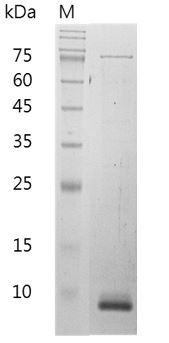| Product name | Mouse CXCL11 Protein, His tag (Animal-Free) |
| Sequence | Amino acid sequence derived from Mouse CXCL11(Phe 22-Met 100) (Q9JHH5) was expressed with 6×His tag at the N-terminus |
| Applications | His tag |
| Applications notes | Mouse |
| Activity | Measure by its ability to chemoattract BaF3 cells transfected with human CXCR3.The ED50 for this effect is <10 ng/mL |
| Protein length | The recombinant Mouse CXCL11 consists of 113 amino acids and predicts a molecular mass of 9.92 kDa |
| Preparation method | E. coli |
| Purity | >98% as determined by SDS-PAGE. |
| Alternative | Interferon Inducible T-Cell α Chemokine, I-TAC, B-R1 |
| Formulation | Lyophilized from PBS, pH 7.4 |
| Features & Benefits | Endotoxin: <0.1 EU per 1 μg of the protein by the LAL method. |
| Molecular weight | 9.92 kDa |
| Usage notes | Always centrifuge tubes before opening. It is recommended to reconstitute the lyophilized recombinant protein to a concentration of 0.1-1 mg/mL using the buffer we provided, and keep at room temperature for at least 20 min to fully dissolve. Please avoid vortex vigorously. |
| Storage instructions | Lyophilized protein product should be stored desiccated below -18°C. Upon reconstitution, the protein should be stored at 4°C between 2-7 days and for future use below -18°C. For long term storage it is recommended to add a carrier protein (5% HSA , 10%FBS or 0.1%BSA). Please prevent freeze-thaw cycles |
| Shipping | Gel pack with blue ice. |
| Precautions | The product listed herein is for research use only and is not intended for use in human or clinical diagnosis. Suggested applications of our products are not recommendations to use our products in violation of any patent or as a license. We cannot be responsible for patent infringements or other violations that may occur with the use of this product. |
| Background | C-X-C motif chemokine 11 (CXCL11) also named Interferon-gamma-inducible protein 9 (IP-9), which is a chemokine of the intercrine alpha family. CXCL11 is a 8.8 kDa protein containing 79 amino acid residues. To CXCR3, CXCL11 has higher affinity than CXCL10 and CXCL9 which plays a role in immune activation. CXCL11 induces the activation of T cells which is also a chemotaxis for T cells. CXCL11 is produced in response for IFN Family. |
| Alternative | Interferon Inducible T-Cell α Chemokine, I-TAC, B-R1 |
| Accession | Q9JHH5 |

You must be logged in to post a review.
Reviews
There are no reviews yet.